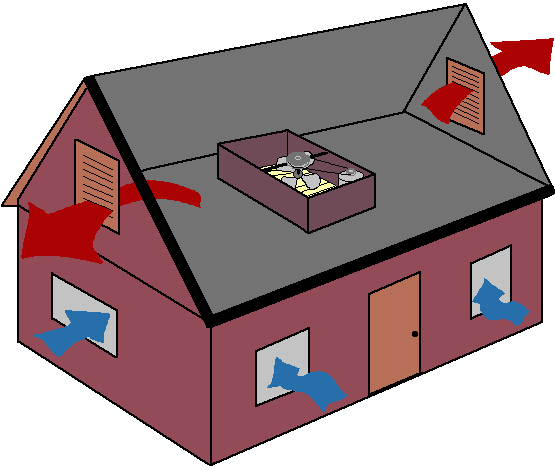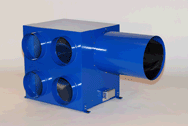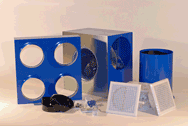When it is cooler outside than it is inside, that difference in temperature can effectively cool the interior of your home at little cost. Just opening the windows doesn’t always do it, however. Natural, convective cooling sometimes needs help.
 Whole house fans, no matter how they have been designed, have no mechanical means for changing the temperature of the air. They are simply air movers. They rely on the temperature difference between the inside and the outside of the house to change the temperature. You can’t cool a house with a whole house fan if it is warmer outside than it is inside! But the cooler it is outside, the faster a whole house fan can bring the temperature down. Imagine turning on any fan when it is 30 degrees outside. The house would cool quickly. Because of physical size and sound level limitations, the amount or volume of airflow (measured in cubic feet per minute or cfm) doesn’t have as great an impact on the rate of cooling as the temperature difference. In fact, as houses get smaller and more energy efficient, it takes less airflow to reduce the temperature just as it takes less heat to warm an efficient house in the cold weather. Efficiency works both ways! Whole house fans, no matter how they have been designed, have no mechanical means for changing the temperature of the air. They are simply air movers. They rely on the temperature difference between the inside and the outside of the house to change the temperature. You can’t cool a house with a whole house fan if it is warmer outside than it is inside! But the cooler it is outside, the faster a whole house fan can bring the temperature down. Imagine turning on any fan when it is 30 degrees outside. The house would cool quickly. Because of physical size and sound level limitations, the amount or volume of airflow (measured in cubic feet per minute or cfm) doesn’t have as great an impact on the rate of cooling as the temperature difference. In fact, as houses get smaller and more energy efficient, it takes less airflow to reduce the temperature just as it takes less heat to warm an efficient house in the cold weather. Efficiency works both ways!
Whole house fans draw the outside air in through open windows, pull it through the house, and then vent it to the outside either by dumping it into the attic or venting directly back outside. Most products work best if they are centrally located, at the top of the stairs, for example. The rooms surrounding the fan need to leave their windows and doors open if they want to share in the cooling effect of the fan.
How much cooling? In the course of an hour 1 cubic foot of air can hold 1.08 BTUs for each degree of temperature difference or change. A fan that moves 1800 cubic feet per minute (cfm) with a 10-degree temperature difference (75 degrees inside and 65 degrees outside) equals 19,440 BTUs. One ton of cooling equals 12,000 BTUs. So an 1800 cfm fan moving air at just a 10-degree temperature difference is equivalent to more than 1.6 tons of free cooling. (Note that whole house comfort ventilators do not dehumidify the air.)
Dumping the air into the attic may seem like a reasonable approach, but it relies on the attic being adequately vented to the outside. Without adequate venting, attic air will be forced back down through wall cavities and other penetrations between the house and the attic – light fixtures, wire runs, can-lights, bath fan penetrations, and ducting.
Why did we design the Comfort Stream? We’ve been designing whole house fans for over 15 years. We could have designed a typical whole house fan that sucks air from the house and forces it out of the  attic. But we wanted something better. We wanted the quietest fan that moved the most air and could prove it under the most rigorous test conditions. We wanted to be able to vent the air all the way to the outside and not force it into the attic. We wanted a fan that was simple to install. In point of fact, we wanted a whole house fan that solved all the problems that we had experienced in all the other whole house fans we had designed and built. We wanted the best for our customers. attic. But we wanted something better. We wanted the quietest fan that moved the most air and could prove it under the most rigorous test conditions. We wanted to be able to vent the air all the way to the outside and not force it into the attic. We wanted a fan that was simple to install. In point of fact, we wanted a whole house fan that solved all the problems that we had experienced in all the other whole house fans we had designed and built. We wanted the best for our customers.
So we started with the right air mover. Axial fans, the big propeller fans, are okay for moving air from one side to the other. They’re very poor at dragging air through ducts because of the resistance. We chose a “motorized impeller” with backward curved blades, specifically designed to pull air through ducts. The motorized impeller in the Comfort Stream is designed, crafted and shipped from Germany for us. Precision built for long, reliable life.
We designed a housing that comes in two pieces that will fit up attic stairs and slide between 16-inch on-center rafters. The housing is powder-coated steel for long, reliable life. The feet include rubber, vibration-absorbing fenders to cut down any noise. The housing is optimized to get the most out of the impeller. The grilles are unique as well, connecting the duct and snapping into place.
The backdraft damper built into the 12 inch exhaust pipe isn’t your typical balanced flap  that robs the system of airflow, but instead we installed a fabric damper, painstakingly hand-made of a specially selected coated nylon material that offers virtually no resistance to the exiting airflow but collapses on itself to prevent any unwanted infiltration. that robs the system of airflow, but instead we installed a fabric damper, painstakingly hand-made of a specially selected coated nylon material that offers virtually no resistance to the exiting airflow but collapses on itself to prevent any unwanted infiltration.
Instead of one central location, the Comfort Stream fan is unique in that it vents from individual rooms through individual ducts and can and should be vented directly to the outside. This avoids over-pressurizing the attic and forcing smelly attic air back down into the house. Room doors can be left closed and privacy can be preserved while comfort is achieved. The Comfort Stream has been tested for airflow and sound level in the same laboratory that tests those really quiet bathroom fans. The sound level at the grilles is a mere 1.9 sones.
What’s a “sone”? One sone is approximately the sound of a quiet refrigerator in a quiet kitchen. It is linear measurement of sound. Two sones, for example, are twice as loud as one sone. The decibel scale, on the other hand, is logarithmic and very difficult to compare. Sone measuring has to be done in a laboratory sound chamber.
|
The Comfort Stream is Certified by the Home Ventilating Institute for airflow and tested by Underwriter Laboratories (UL) for safety. It is listed on the California Energy Commissions product efficiency list. We suggest you ask other manufacturers what Certification comes with their products. Independent, industry Standards tested through the Home Ventilating Institute (HVI) are currently the only Standards that are used by many state and local regulatory agencies.
So there are a lot of whole house fans on the market making a lot of claims. If you want to generate a breeze blowing through the house, think about using one of the big propeller fans and be willing to put up with the noise, pressurize the attic, and keep the bedroom doors open at night.
But if you want a quiet whole house comfort ventilator (that’s what HVI calls them) that will run quietly and reliably for a long time, ask us about the Comfort Stream. It’s the premier whole house fan that we use and recommend for family and friends’ homes.
What's a sone? One sone is approximately the sound of a quiet refrigerator in a quiet kitchen. It is a linear measurement of sound. Two sones, for example, are twice as loud as one sone. The decibel scale, on the other hand, is logarithmic and very difficult to compare. Sone measuring has to be done in a laboratory sound chamber.
Final notes– Whole house fans are not attic fans and they are not for improving indoor air quality. They are for changing the temperature in the house using the cooler, outside air that nature provides.
Whole house fans should NEVER be used without opening windows. They won’t work and they may backdraft water heaters and other combustion appliances. It is risky to control a whole house fan with a timer if the system might be activated when no one is home and the windows might be tightly closed.
|